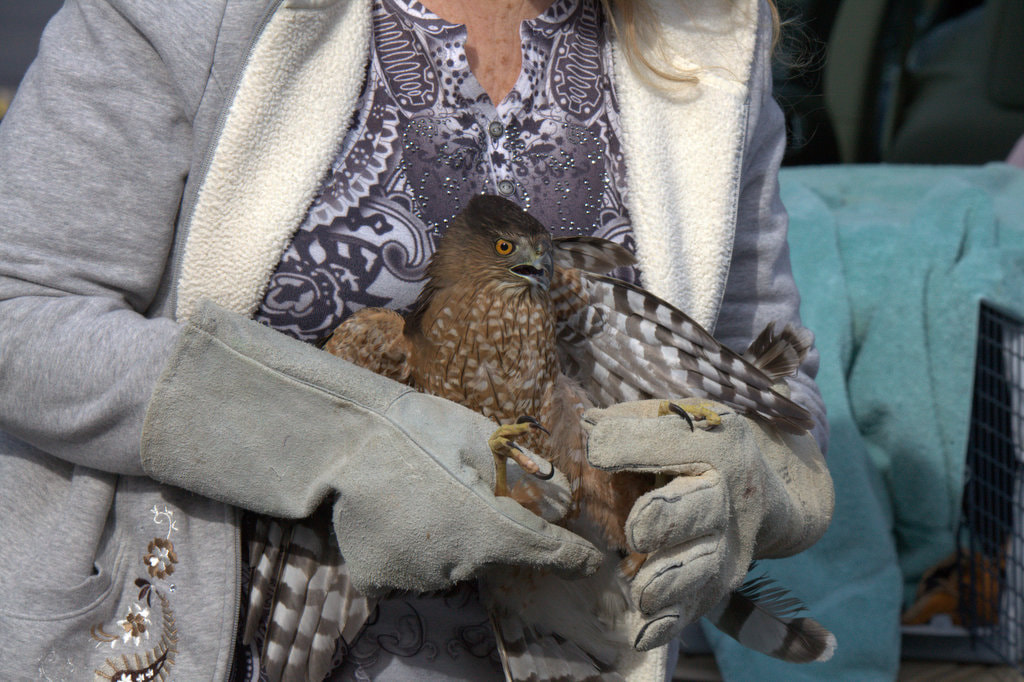the Cooper's Hawk

Bird identification can be difficult. Males may look different than females. Juveniles look different than adults. Some species look so similar it confuses even the experts.
In the 19th century, the barnyard chicken was a common prey of the Cooper’s Hawk which earned it the nickname of “Chicken Hawk” and was frequently shot on sight. Since some hawks look so similar and most people were not able, or unwilling to distinguish between different hawks, all hawks became “chicken hawks” and all were slaughtered by the thousands. So, let’s try to figure this out. Is it a Cooper’s Hawk or a very similar looking Sharp-Shinned Hawk? These two birds can look so similar that experts can be fooled. Cooper’s hawks have a square head and look like they are wearing a cap. The head has a dark gray crown above a slightly paler nape (sharp-shinned head color continues down the nape and back). The back and wings are a medium slate gray and have no barring. On both hawks, the breast and underside are barred with white and rust color. The tail is long and rounded on the Cooper’s hawk (the sharp-shinned is squared) and has a white band at the end. The legs of a Cooper’s hawk are about the width of a pencil (sharp-shinned are thinner). Overall, the Cooper’s hawk is a larger bird than the sharp-shinned hawk and due to its size is able to kill larger prey. Their diet consists of medium-sized birds such as European Starlings, Mourning Doves, Rock Pigeons, American Robins, jays, quail, pheasants and more. Small birds are safer from Cooper’s Hawks. Here in the west, Cooper’s Hawks also dine on small mammals such as chipmunks, hares, mice and squirrels. These skilled fliers hunt by flying low to the ground chasing prey through vegetation. These hawks are native to North America and are found in forests and woodlands but also in the suburbs, parks, and quiet neighborhoods. Their average life span is 10-12 years. Our pines and oaks are common nesting sites. Males will build the nest taking about two weeks to complete. Located 25-50 feet high, the nests are piles of sticks with a depression in the middle. The cup is lined with bark and small green twigs. Here, the female will lay 2 – 6 eggs which incubate for 30-36 days. When hatched, the nestlings are covered with white down and weight only about one ounce. After about 30 days, the young hawks move from the nest to branches of the tree and will call and beg for food. The parents bring food to the nest for the next ten days or so. When they are about eight weeks old, the juveniles start to hunt for themselves but still depend on parents. After leaving the parents range, siblings will stay close to one another, hunting and stealing prey from each other. The bird feeder you have in your backyard may attract Cooper’s Hawks who will dine on those feathered friends you invited for dinner. If the Cooper’s Hawk becomes a problem for you, take down your feeders for a few days and the hawk will look elsewhere for its dinner. Tri County Wildlife Care, a local nonprofit started in 1994, is dedicated to the rescue and rehabilitation of our native wildlife and helping our community live in balance with wildlife. They envision a world where wildlife and people thrive together. For more information call (209) 283-3245, or visit pawspartners.org.Red Tailed Hawk (Buteo jamaicensis) This is the most common hawk in North America and will be found in every type of open habitat. As one of the most frequently observed raptors in our region, you will find them soaring above open fields or perched atop telephone poles looking for their next meal. Though these are one of the largest birds you will see, even the largest females will weigh only about 3 pounds. Females are larger than males, and from a distance might fool you into thinking you see an eagle. Hard to believe, but when first hatched, they weigh only 2 ounces! Red-tailed hawks have large, broad, rounded wings, and a short, wide tail. Generally, they are rich brown above and pale underneath with the tail a cinnamon-red on top and pale below. Young birds don’t develop the rich red color in their tails until their second year. These hawks mostly eat mammals including voles, mice, wood rats, rabbits, and squirrels. They will also eat birds as well as snakes and carrion. Prey can weigh anywhere from less than an ounce to more than 5 pounds. Their diet helps farmers and gardeners by helping to eliminate destructive vermin. Our landscaping with isolated trees or small woodlots provides nest sites and elevated perches for hunting. Their numbers have increased in North America as they have adapted so well to living alongside humans. If you would like to see more of red-tailed hawks from the comfort of your home, check out Cornell Lab of Ornithology’s web cam of Big Red and Arthur. Red-tailed hawks frequently mate for life, and these two have nested at the university’s athletic field the last few years. The web cam will show all the activity from the egg laying during the fourth week of March, hatching near the end of April and their fledging mid-June. See it all here - Hawk Cam. And if you would like to see a red-tailed hawk up close and personal, schedule a Saving Wildlife Saves Us presentation with Tri County Wildlife Care and Wally, our education ambassador. Wally was hit by a car which left him blind in one eye and a little slow. He is unable to fly or land well and so unable to hunt adequately. Call 209-283-3245 to schedule a free wildlife class. |
Learn More!
|

